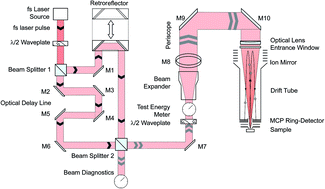当前位置:
X-MOL 学术
›
J. Anal. At. Spectrom.
›
论文详情
Our official English website, www.x-mol.net, welcomes your feedback! (Note: you will need to create a separate account there.)
Mass spectrometric analysis of the Mg plasma produced by double-pulse femtosecond laser irradiation
Journal of Analytical Atomic Spectrometry ( IF 3.4 ) Pub Date : 2018-05-18 00:00:00 , DOI: 10.1039/c8ja00036k M. Tulej 1, 2, 3, 4, 5 , R. Wiesendanger 1, 2, 3, 4, 5 , A. Riedo 1, 2, 3, 4, 5 , G. Knopp 5, 6, 7, 8 , P. Wurz 1, 2, 3, 4, 5
Journal of Analytical Atomic Spectrometry ( IF 3.4 ) Pub Date : 2018-05-18 00:00:00 , DOI: 10.1039/c8ja00036k M. Tulej 1, 2, 3, 4, 5 , R. Wiesendanger 1, 2, 3, 4, 5 , A. Riedo 1, 2, 3, 4, 5 , G. Knopp 5, 6, 7, 8 , P. Wurz 1, 2, 3, 4, 5
Affiliation

|
The capabilities of a double-pulse (DP) femtosecond (fs) laser ablation of solid materials as an ion source for application in a miniature Laser ionisation time-of-flight Mass Spectrometer (LMS) system designed for space research are investigated. The studies are conducted by irradiating a high-purity Mg sample with sequences of two femtosecond laser pulses. The positively charged fraction of the Mg plasma is analysed as a function of the inter-pulse delay in the range from 0 to 300 ps and for pulse energies in the range from 0.2 to 1 μJ. The DP ablation studies with both pulses of similar energy show a Mg+ ion yield enhancement within the inter-pulse delay range from 1 to 35 ps near the ablation energy threshold (AET) and from 1 to ∼300 ps if larger pulse energies are applied for the first ablation pulse. For the same total energies but different individual pulse energies, Mg+ ions are produced more efficiently if the weaker pulse is applied first. The analyses of Mg+, multiple-charged Mg and Mg cluster ion yields as a function of the inter-pulse delay and the pulse energies improve the understanding of the ablation mechanism and add some insights into the dynamics of the Mg-surface melting and cooling phases, thermal characteristics of the expanding plasma plume and atomic/cluster ion production mechanisms. By applying sufficiently high DP energies > (0.3 + 0.3) μJ the clusters which are likely produced in the initial ablation phase at the surface can be decomposed effectively in the heated plasma plume. Moreover, by tuning the inter-pulse delay one can also efficiently suppress the neutral-ion reactions in post-plasma chemistry. Our studies show that the DP femtosecond laser ablation ion source can improve the mass spectrometric analysis of solid samples by increasing the ion yield of atomic ions and reducing the abundance of cluster ions. This can improve the quantitative analyses of elements and their isotopes by increasing signal-to-noise ratios and reducing isobaric interferents arising from cluster ions. The current DP studies are conducted successfully with pulse energies lower than 1 μJ, which is sufficiently low to be realised in a compact, lightweight system using fibre technology based lasers, suitable for in situ space applications.
中文翻译:

双脉冲飞秒激光辐照产生的镁等离子体的质谱分析
研究了固态材料的双脉冲(DP)飞秒(fs)激光烧蚀作为离子源的能力,该离子源用于为空间研究设计的微型激光电离飞行时间质谱仪(LMS)系统中。通过用两个飞秒激光脉冲序列照射高纯度的Mg样品进行研究。根据脉冲间延迟(范围为0到300 ps)和0.2到1μJ范围内的脉冲能量,对Mg等离子体的带正电的分数进行分析。用相似能量的两个脉冲进行的DP消融研究显示Mg +在第一个消融能量阈值(AET)附近的脉冲间延迟范围内,离子产量提高幅度为1到35 ps;如果对第一个消融脉冲施加更大的脉冲能量,则在1到〜300 ps范围内。对于相同的总能量,但不同的单个脉冲能量,如果先施加较弱的脉冲,则会更有效地产生Mg +离子。镁+的分析,多次充电的Mg和Mg团簇离子的产量随脉冲间延迟和脉冲能量的变化而变化,这加深了人们对烧蚀机理的理解,并为Mg表面熔化和冷却阶段的动力学,热力学特性提供了一些见识。不断扩大的等离子体羽流和原子/簇离子产生机制。通过施加>(0.3 + 0.3)μJ的足够高的DP能量,可以在加热的等离子体羽流中有效分解表面上初始烧蚀阶段中可能产生的团簇。此外,通过调节脉冲间延迟,还可以有效地抑制等离子体后化学反应中的中性离子反应。我们的研究表明,DP飞秒激光烧蚀离子源可通过增加原子离子的离子收率和减少簇离子的丰度来改善固体样品的质谱分析。通过增加信噪比和减少簇离子引起的同量异位干扰物,可以改善元素及其同位素的定量分析。当前的DP研究成功地使用了低于1μJ的脉冲能量,该能量足够低,可以使用基于光纤技术的激光器在紧凑,轻巧的系统中实现,适用于原位空间应用。
更新日期:2018-05-18
中文翻译:

双脉冲飞秒激光辐照产生的镁等离子体的质谱分析
研究了固态材料的双脉冲(DP)飞秒(fs)激光烧蚀作为离子源的能力,该离子源用于为空间研究设计的微型激光电离飞行时间质谱仪(LMS)系统中。通过用两个飞秒激光脉冲序列照射高纯度的Mg样品进行研究。根据脉冲间延迟(范围为0到300 ps)和0.2到1μJ范围内的脉冲能量,对Mg等离子体的带正电的分数进行分析。用相似能量的两个脉冲进行的DP消融研究显示Mg +在第一个消融能量阈值(AET)附近的脉冲间延迟范围内,离子产量提高幅度为1到35 ps;如果对第一个消融脉冲施加更大的脉冲能量,则在1到〜300 ps范围内。对于相同的总能量,但不同的单个脉冲能量,如果先施加较弱的脉冲,则会更有效地产生Mg +离子。镁+的分析,多次充电的Mg和Mg团簇离子的产量随脉冲间延迟和脉冲能量的变化而变化,这加深了人们对烧蚀机理的理解,并为Mg表面熔化和冷却阶段的动力学,热力学特性提供了一些见识。不断扩大的等离子体羽流和原子/簇离子产生机制。通过施加>(0.3 + 0.3)μJ的足够高的DP能量,可以在加热的等离子体羽流中有效分解表面上初始烧蚀阶段中可能产生的团簇。此外,通过调节脉冲间延迟,还可以有效地抑制等离子体后化学反应中的中性离子反应。我们的研究表明,DP飞秒激光烧蚀离子源可通过增加原子离子的离子收率和减少簇离子的丰度来改善固体样品的质谱分析。通过增加信噪比和减少簇离子引起的同量异位干扰物,可以改善元素及其同位素的定量分析。当前的DP研究成功地使用了低于1μJ的脉冲能量,该能量足够低,可以使用基于光纤技术的激光器在紧凑,轻巧的系统中实现,适用于原位空间应用。



























 京公网安备 11010802027423号
京公网安备 11010802027423号